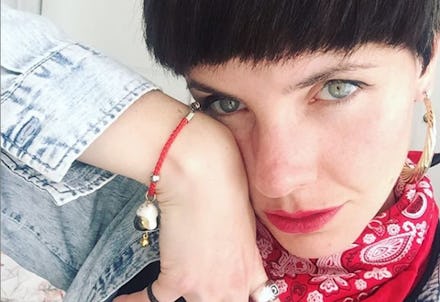These Mexican artists aim to take the stigma out of the most common STD

When I walked into Feminasty, an event showcasing the work of feminist artists at La Nana, a contemporary arts center in Mexico City, I immediately gravitated towards a table covered in vagina stickers. These weren’t your oppressive Barbie-pink vagina stickers. They were edgy, minimal vulvas emblazoned with the words, “Honor & Glory.”
I immediately asked Marina Corach, the artist, to tell me about her work. Luckily, her English was a lot better than my Spanish. “I made this when I was diagnosed with human papilloma virus, which is called 'VPH' in Mexico,” she told me, “It was hard to deal with, and this is how I coped.” I told her I had it too, and we smiled at each other with a strange sense of solidarity. I bought her fanzine, also called Honor & Glory.
Human Papillomavirus, commonly referred to as HPV in the US and VPH in Mexico, is a very common sexually transmitted infection. To paint a picture of how widespread it is, around 80% of sexually active Americans will have HPV by the time they hit 50. There are hundreds of strains of HPV, though, with just as many symptoms that range from genital warts to cervical cancer — many strains exhibit mild or no evident symptoms. Many bodies will fight it off naturally and those folks will not even test positive for HPV.
More harmful strains of HPV (that appear more rarely) are the leading cause of cervical cancer (which is one of the most common cancers among women in Mexico and in the States). Women who test positive for HPV and have a pap that indicates cancerous activity require surgical treatment that removes cancerous cells from the cervix. Either way, as long as a woman tests positive for HPV, whether she has warts, precancerous activity, or a less concerning diagnosis, she carries both the responsibility of the infection and the stigma of sharing her status with sexual partners.
Corach, a 33-year-old Mexican graphic designer and illustration artist, shows her empathetic side immediately when discussing this concept. “Anguish is the best friend of the disease,” she wrote in Honor & Glory. I asked Corach how she conceived of the drawings. “It was very natural in the sense that I didn’t question it. It was an impulse from inside the drawing. It was a way to process and enact what I was living through and give it the necessary importance. I wanted to live through it with honor and glory.”
Corach’s work allows her to begin conversations about VPH that might be difficult to otherwise initiate. “I think it is important not to be afraid to talk about this,” she said, “and to talk about it in unfamiliar environments. I talk about VPH with male friends who have had an interest. I talk about VPH to the lady who sells me herbs in the market. The feedback is incredible. This is how we create the possibility for change.”
Corach had to undergo many expensive and invasive medical procedures to treat her own HPV. She was diagnosed with a strain of it that requires immediate surgery to prevent future complications. It was a physically exhausting process. But the emotional recovery was equally important to her — it yielded art. Corach told me that reclaiming sensuality was also a crucial part of healing for her.
“It is very beautiful to get rid of guilt, grief, and evasion,” she said. “It made me more empathetic and responsible with my sexuality. I think that the concept of sensuality can be constantly reinvented. For me, personal and collective care is sexy.”
After speaking with Corach and browsing the other exhibits, I walked up the stairs at La Nana, a train station that has been repurposed to showcase exhibitions, and saw a giant piece of fabric covered with circles that read, “Zona VPH.” It looked like a delicate but urgently-hand-made quilt. I was surprised and pleased to see so much HPV-themed art.
Most everyone knows about HPV and everyone knows that almost everyone of a certain age (ahem) has been exposed to it, but the experience of an STD is still one steeped in shame and emotional labor. Since everyone knows, but we never talk about it, it’s easy to forget there are real bodies and real human feelings involved.
The fabric circles, it turned out, were hand embroidered patches made by an artist called ANOMALÍA, a moniker which means “anomaly.” There were scissors nearby so that people could cut off their own patch and wear it. “My piece ‘Zona VPH’ came to me after I was diagnosed. I needed to see that there are other possibilities to understand our experiences outside of the medical understanding,” ANOMALÍA told me, about her inspiration for the patches. “More than inspiration, this piece is born from the need to not feel lonely during VPH diagnosis.”
“When I started to research VPH, I came to understand the commonality of this virus,” she went on, “and that there were other people with this experience who probably felt like I did, isolated and scared. With ‘Zona VPH,’ I try to invite you to reflect on the experience that people are having and question the medical discourse.”
ANOMALÍA aims to remind people, with her work, of the real human experience of folks diagnosed with HPV. “It is important that we take care of our bodies and stop silencing and privatizing them. It is very important to talk about papilloma from our lived experience and not let it be only the medical establishment that speaks for our bodies.”
These artists, then, are giving a voice to the experience of people with HPV that speaks over medicalized discourse. Their work shows how hurtful and alienating the experience of treatment and the stigma attached to the virus can be and initiates a conversation rooted in empathy and care.